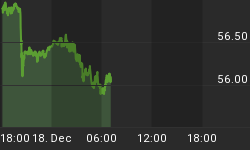Inexperienced investors in the commodity markets should keep in mind that while gold and silver look good now, silver dropped 59% in the last bear market and gold fell 32%. Both silver and gold held up better than stocks (and the dollar) early in the last bear market (as they are now), but eventually deflationary fears caught up with precious metals. Risk management is required for all positions, even "safe" positions like gold and silver. We own both gold and silver, but it is important that we understand the downside potential of any asset.

The chart below shows the performance of the U.S. Dollar Index relative to gold (2008-2009). Notice between points A and B, the dollar began to form a base relative to gold, which was a warning to watch gold holdings more closely. Gold peaked on March 17, 2008, just as the dollar/gold ratio was forming a base.

The chart below shows the U.S. Dollar Index in 2008. The Ultimate Oscillator, near point A, perked up as the dollar began to strengthen in a more meaningful manner. Near point B, the 200-day moving average began to flatten out, indicating a weakening downtrend. Near point C, the slope of the 50-day moving average turned up, which was another feather in the dollar bulls' cap.

The chart below shows the dollar in 2011. In terms of similarities to the chart above, it is a mixed bag. Near point A the Ultimate Oscillator has shown some strength similar to 2008. However, the slope of the 200-day (point B) is still pointing down and not close to flattening out. The slope of the 50-day, near point C, does indicate a market that is trying to form a base. ADX, near point D, indicates a somewhat trendless or sleepy dollar. Sleepy markets often make a sharp move higher or lower when they wake up.

If the chart of the dollar/gold ratio begins to look more like the second chart presented above, in terms of forming a base, we would become a little more cautious on our gold holdings. The dollar switched places with gold in 2008 in terms of taking the "safe haven" lead. We may not see that switch take place in the near future with the budget and entitlement mess in the United States, but we must keep on eye on the dollar to properly manage our gold and silver.
We remain concerned about the possible domino effect on the economy with the first domino being government debt. The technical deterioration and fundamental problems outlined in our August 14 video also need to be monitored very closely.















